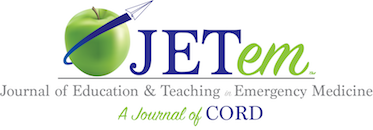A Recipe for Disaster – Sodium Bicarbonate Overdose
ABSTRACT:
Audience:
Emergency medicine residents post-graduate years 1-4
Introduction:
Sodium bicarbonate is a compound found commonplace in many households and in many products. It lends itself to countless everyday uses including cooking and cleaning. Physicians prescribe sodium bicarbonate regularly both on- and off-label regularly for various ailments.1 Due to the ubiquitous way both emergency physicians and the general public use and are exposed to sodium bicarbonate, we wanted to prepare learners to identify and appropriately manage sodium bicarbonate toxicity.
Obtaining a thorough history not just of medications prescribed but of significant ingestions or infusions is critical in diagnosing this toxicity. Furthermore, acute sodium bicarbonate overdose should be considered in a patient who may present with severe metabolic alkalosis.1 This case outlines the common signs and symptoms of a patient with acute sodium bicarbonate toxicity and reviews the management of sodium bicarbonate toxicity.
Educational Objectives:
At the end of this oral board session, learners will be able to: 1) obtain a history which includes medications and other supplements used by the patient, 2) interpret a prolonged QTc, 3) diagnose metabolic alkalosis due to sodium bicarbonate toxicity, and 4) manage sodium bicarbonate toxicity with fluid and electrolyte resuscitation.
Educational Methods:
This case was presented to learners using the typical format for the American Board of Emergency Medicine (ABEM) oral certification examination, a standardized test of emergency medicine knowledge. This educational format allows exploration of the evaluation, workup, and management of the rare case of a patient with sodium bicarbonate toxicity in a safe learning environment.
For faculty, this case can act as an assessment of an emergency medicine resident’s critical thinking skills as they progress through residency. Oral board testing is a key part of resident learning because it prompts residents to apply their learning in a low-stakes environment, both in preparation for the oral certification examination and for clinical practice.
Research Methods:
Immediately after the learners completed the oral boards case and debriefing, feedback was solicited using Google forms, a free and open-access online tool. The participants’ feedback was recorded regarding the educational value of the case, using a Likert scale (1-5), and the form also requested feedback about the case, including what was beneficial, and suggestions for improvement.
Results:
Twenty-six residents in total participated in this oral boards case and five faculty participated as facilitators. All participating faculty gave verbal feedback. After participating in the case, thirteen residents who completed the feedback form described a score of 4 and 5 on the Likert scale (1-5, 1 = very unfamiliar, 5 = very familiar) regarding diagnosing and managing sodium bicarbonate toxicity.
Discussion:
Sodium bicarbonate toxicity is a true medical emergency at the intersection of multiple bodily systems but particularly that of managing fluids and electrolytes. It requires timely diagnosis and management, albeit the occurrence of the toxicity is rare. Acidosis is a far more common occurrence in emergency medicine. This case allows resident learners to explore a rare acid/base imbalance. The educational content of this oral boards case was effective based on the reports of the learners’ familiarity with the subject before and after working through the case. In addition, many residents reported that this educational technique was a good way to learn about a rare patient presentation, diagnosis, and management. We learned that this case was considered more difficult compared to cases focusing on emergency core content diagnoses. However, though it is difficult, the learners appreciated putting together skills they’ve learned from core content and basic emergency medicine patient care concepts to work through this case, which they considered applicable to their future patient care.
Topics:
Sodium bicarbonate, baking soda, alkalosis, hypokalemia, hypernatremia, toxicology, prolonged QTc, oral board case.
